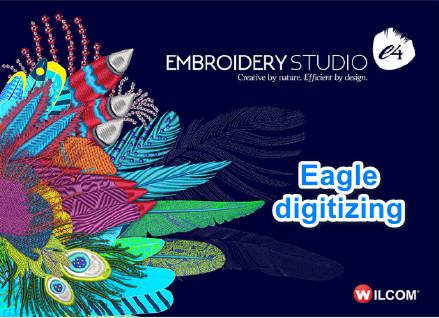Find the Right Embroidery Digitizing Software for Your Needs
In the realm of embroidery, selecting the right digitizing software is crucial to achieving the best results. The software you choose will influence not only the quality of your designs but also the efficiency of your workflow. A tailored software solution can simplify complex tasks, enhance design precision, and align with your project requirements. As embroidery technology advances, the array of software options expands, making it imperative to choose a tool that matches your specific needs and skill level.
How Specific Needs Influence the Selection of Digitizing Software
Embroidery digitizing software is not a one-size-fits-all solution. Whether you're a hobbyist, a professional, or operating a commercial business, your needs will dictate the features and capabilities required. Customization options, ease of use, advanced functionalities, and budget constraints all play a role in determining the best software for your projects. Understanding these needs allows you to make an informed choice that optimizes both your creative process and operational efficiency.
Choosing Software for Different Needs
Customization and Flexibility: Software for Personalized Designs
For those focused on creating unique, personalized designs, flexibility and customization are paramount. Software with robust customization tools allows you to modify every aspect of your design, from stitch types to thread colors. Look for features that enable easy manipulation of design elements, so you can craft intricate and personalized embroidery projects with precision. The ability to adapt the software to your creative vision ensures that each design is truly one-of-a-kind.
Advanced Features for Professional Use: Tools for Complex Projects
Professional embroidery projects often require sophisticated features that can handle complex designs. Advanced software options offer tools for intricate pattern creation, precise stitch control, and multi-color management. Features like auto-digitizing, advanced stitch type settings, and layered designs are essential for tackling high-end, detailed projects. For professionals, investing in software with these advanced capabilities can significantly enhance productivity and design quality.
User-Friendly Options: Software for Beginners and Hobbyists
For beginners and hobbyists, ease of use is key. User-friendly software with intuitive interfaces, guided tutorials, and basic functionalities can help new users quickly get up to speed. These options often include simple drag-and-drop features, pre-set templates, and straightforward stitch management. Choosing software that balances functionality with ease of use can make learning smoother and more enjoyable.
Software for Commercial Embroidery
Scalability: How to Choose Software for Large-Scale Production
In commercial embroidery settings, scalability is crucial. Software designed for large-scale production should handle high volumes of orders and support multiple designs and formats efficiently. Look for features that facilitate batch processing, automated workflows, and robust data management. Scalability ensures that your software can keep up with increasing demands as your business grows without compromising on performance.
Integration with Other Systems: Accounting, Inventory, and Order Management
Effective commercial embroidery operations often require integration with other systems such as accounting, inventory, and order management. Software that offers seamless integration capabilities allows for streamlined operations, from tracking orders and managing inventory to processing payments. This connectivity can enhance operational efficiency and reduce the risk of errors across different facets of your business.
Support for Multi-Head Machines: Features for Efficient Operation
If your commercial setup includes multi-head embroidery machines, it's essential to choose software that supports their operation. Features to look for include the ability to manage multiple heads, synchronize designs across machines, and optimize stitching patterns for simultaneous use. Proper software support ensures that you can fully leverage the capabilities of your multi-head machines, increasing productivity and efficiency.
Software for Home Embroidery
Budget-Friendly Options: Affordable Digitizing Software for Hobbyists
Home embroiderers often seek cost-effective solutions that offer good value for money. Budget-friendly software typically includes essential features without the premium price tag of professional tools. Look for software that provides a balance of functionality and affordability, offering the basic tools needed for home projects while keeping costs manageable.
Ease of Use: User-Friendly Interfaces for Quick Learning
For home users, ease of use is critical. Software with a simple, intuitive interface helps users quickly learn how to navigate the tools and features. User-friendly options often include easy-to-follow instructions, customizable layouts, and straightforward design manipulation. This ease of use allows hobbyists to focus on their creativity without being bogged down by complex software navigation.
Basic Features vs. Advanced Tools: What’s Essential for Home Use
When selecting software for home embroidery, consider what features are essential for your needs. Basic features might include simple design editing, basic stitch types, and color management. Advanced tools, while useful, may not be necessary for all home users. Understanding what you need for your specific projects can help you choose software that provides the right balance between simplicity and functionality.
Software for Specific Design Styles
Monogramming Software: Special Features for Elegant Monogram Designs
Monogramming software caters to those focusing on elegant, personalized monogram designs. Look for features that support intricate lettering, customizable fonts, and alignment tools. Specialized monogramming software often includes templates and design elements tailored to create stylish and sophisticated monograms, making it easier to achieve professional-looking results.
Appliqué Digitizing: Tools for Creating Layered Fabric Designs
Appliqué digitizing software is designed for creating layered fabric designs. It provides tools for defining fabric layers, stitch types, and edge finishes. Features such as automatic placement and fabric-specific settings are crucial for producing clean, well-executed appliqué designs. This software helps streamline the process of incorporating different fabrics into your embroidery projects.
Embossing and 3D Effects: Software for Textured and Raised Embroidery
For those interested in adding texture and dimension to their embroidery, software with embossing and 3D effects is ideal. This software allows for the creation of raised designs and textured patterns, adding a unique tactile element to your projects. Features might include 3D stitch types, shadow effects, and texture settings, enabling you to produce eye-catching, dimensional embroidery.
Industry-Specific Software
Apparel and Fashion: Features for Trendy and Functional Clothing Designs
In the apparel and fashion industry, software needs to support both trendy and functional designs. Look for features that accommodate various garment types, handle complex patterns, and offer customization options for logos and embellishments. Software that supports industry-specific requirements, such as size grading and fabric compatibility, can help ensure your designs are both stylish and practical.
Sports and Teamwear: Customization Tools for Logos and Numbers
Sports and teamwear require software that excels in customizing logos, numbers, and other design elements. Features to consider include easy-to-use tools for placing and adjusting text and graphics, as well as options for creating and managing team logos. Effective software can streamline the process of producing uniform designs that meet team and league standards.
Corporate Branding: Software for Consistent and Professional Business Logos
Corporate branding software should provide tools for creating consistent, professional business logos and designs. Look for features that support precise color matching, high-resolution outputs, and consistent branding elements. Software that integrates well with corporate branding guidelines helps maintain a uniform image across various materials and platforms.
Comparing Popular Software Options
Software Reviews: Analyzing User Feedback and Ratings
Analyzing user reviews and ratings provides insights into the strengths and weaknesses of various software options. Reviews can highlight user experiences, ease of use, and customer support, helping you make an informed decision. Consider feedback from others in the embroidery community to gauge how well a software meets real-world needs.
Feature Comparisons: How Leading Software Stacks Up Against Each Other
Feature comparisons allow you to evaluate how different software options measure up against each other. Compare functionalities such as design tools, customization options, and integration capabilities to determine which software best fits your needs. This comparison helps you identify the software that offers the most value for your specific requirements.
Cost vs. Value: Evaluating Pricing Models and Software Benefits
When choosing software, evaluate the cost against the benefits it offers. Consider pricing models, such as one-time purchases or subscription plans, and assess how well the software’s features justify the investment. Balancing cost and value ensures you get the best return on investment for your embroidery needs.
Customization and Personalization
Custom Toolsets: Tailoring Software to Your Specific Design Needs
Custom toolsets allow you to tailor software to your specific design needs. Look for options that let you create or adjust toolsets based on your unique requirements. Customization helps streamline your workflow and enhances efficiency by focusing on the tools you use most frequently.
Personalized User Interfaces: Adjusting Layouts and Workflows for Efficiency
Personalized user interfaces enable you to adjust layouts and workflows to match your preferences. Customizable interfaces allow you to arrange tools and panels according to your workflow, making it easier to access frequently used features. This personalization enhances your overall efficiency and comfort while working with the software.
Saving and Reusing Settings: Streamlining Your Digitizing Process
Saving and reusing settings help streamline your digitizing process. Look for software that allows you to save presets, templates, and frequently used configurations. This functionality reduces repetitive tasks and speeds up the design process, allowing you to focus more on creativity.
Making the Right Choice
Assessing Your Needs: How to Determine the Best Software for You
Assessing your needs involves evaluating your specific requirements, such as design complexity, budget, and usability. Determine what features are essential for your projects and choose software that aligns with these needs. A thorough assessment ensures that you select a tool that fits your workflow and goals.
Trial Versions and Demos: Testing Software Before Committing
Trial versions and demos provide an opportunity to test the software before committing. Use these trials to explore the features, interface, and performance of different options. Testing helps you make an informed decision and ensures that the software meets your expectations.
Final Recommendations: Choosing the Software That Fits Your Goals
Choosing the right software involves considering all factors, including features, ease of use, cost, and compatibility. Review your options, weigh the benefits and drawbacks, and select the software that best fits your goals and requirements. A well-chosen tool will enhance your embroidery projects and contribute to your overall success.
Tailoring software to your specific needs is crucial for optimizing your embroidery projects. By choosing software that aligns with your requirements, you ensure that your designs are executed with precision and efficiency. Understanding and addressing your unique needs helps maximize the potential of your embroidery endeavors.
Explore different software options to find the best tools for your creative vision. Experiment with various features, read user feedback, and test software through demos to discover what works best for you. Embracing the right tools allows you to fully realize your embroidery potential and achieve exceptional results.



.png)